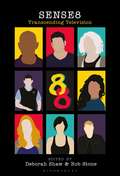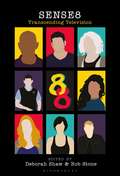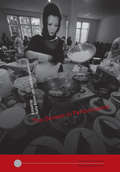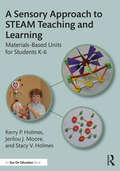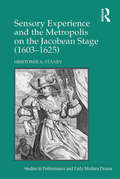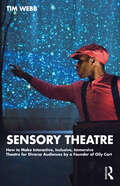- Table View
- List View
Sense8: Transcending Television
by Deborah ShawThis collection explores the many ways in which the Netflix series Sense8 transcends television. As its characters transcend physical and psychological borders of gender and geography, so the series itself transcends those between television, new media platforms and new screen technologies, while dissolving those between its producers, stars, audiences and fans. Sense8 united, inspired and energized a global community of fans that realized its own power by means of online interaction and a successful campaign to secure a series finale. The series' playful but poignant exploration of globalization, empathy, transnationalism, queer and trans aesthetics, gender fluidity, imagined communities and communities of sentiment also inspired the interdisciplinary range of contributors to this volume. In this collection, leading academics illuminate Sense8 as a progressive and challenging series that points to vital, multifarious, contemporary social, political, aesthetic and philosophical concerns. Sense8: Transcending Television is much more than an academic examination of a series; it is an account and analysis of the way that we all receive, communicate and consider ourselves as participants in global communities that are social, political and cultural, and now both physical and virtual too.
Sense8: Transcending Television
This collection explores the many ways in which the Netflix series Sense8 transcends television. As its characters transcend physical and psychological borders of gender and geography, so the series itself transcends those between television, new media platforms and new screen technologies, while dissolving those between its producers, stars, audiences and fans. Sense8 united, inspired and energized a global community of fans that realized its own power by means of online interaction and a successful campaign to secure a series finale. The series' playful but poignant exploration of globalization, empathy, transnationalism, queer and trans aesthetics, gender fluidity, imagined communities and communities of sentiment also inspired the interdisciplinary range of contributors to this volume. In this collection, leading academics illuminate Sense8 as a progressive and challenging series that points to vital, multifarious, contemporary social, political, aesthetic and philosophical concerns. Sense8: Transcending Television is much more than an academic examination of a series; it is an account and analysis of the way that we all receive, communicate and consider ourselves as participants in global communities that are social, political and cultural, and now both physical and virtual too.
Sensemaking and Neuroaesthetics: Neuroarts and the Spectrum of Neurodiverse Experiences
by James Hutson Piper Hutson Morgan Harper-NicholsThis book investigates the complex interrelationships between neuroscience, arts, technical design, and the spectrum of neurodivergent conditions, introducing the emerging topic of neuroarts. It emphasizes the power of art and technologies as a multisensory tool for helping neurodivergent individuals discover their sensory preferences, and for neurotypical individuals to broaden their understanding of the world by simulating different sensory experiences. Drawing on the enactivism theory, which posits that cognitive processes are inherently shaped through the dynamic interplay between an organism and its environmental context, the authors discuss the applications of emerging technologies and propose a new theory to discuss and identify ‘neurotribes’ based on their relation to sense making or the body.A timely and well-needed resource for scholars in the fields of neuroaesthetics and neurodiversity, as well as art therapists, clinical psychologists, and medical practitioners specializing in neurodiversity and sensory perception disorders, this book can also serve cultural institutions developing inclusive experiences for a neurodiverse public, and professionals in the tech industry focusing on AI, augmented reality, and sensory technology.
The senses in interior design: Sensorial expressions and experiences (Studies in Design and Material Culture)
by John Potvin, Marie-Ève Marchand and Benoit BeaulieuThe senses in interior design examines how sight, touch, smell, hearing and taste have been mobilised within various forms of interiors. The chapters explore how the body navigates and negotiates the realities of designed interiors and challenge the traditional focus on star designers or ideal interiors that have left sensorial agency at the margins of design history. From the sensually gendered role of the fireplace in late sixteenth century Italy to the synaesthetic décors of Comte Robert de Montesquiou and the sensorial stimuli of Aesop stores, each chapter brings a new perspective on the central role that the senses have played in the conception, experiences and uses of interiors.
The senses in interior design: Sensorial expressions and experiences (Studies in Design and Material Culture)
by John Potvin Marie-Ève Marchand Benoit BeaulieuThe senses in interior design examines how sight, touch, smell, hearing and taste have been mobilised within various forms of interiors. The chapters explore how the body navigates and negotiates the realities of designed interiors and challenge the traditional focus on star designers or ideal interiors that have left sensorial agency at the margins of design history. From the sensually gendered role of the fireplace in late sixteenth century Italy to the synaesthetic décors of Comte Robert de Montesquiou and the sensorial stimuli of Aesop stores, each chapter brings a new perspective on the central role that the senses have played in the conception, experiences and uses of interiors.
The Senses in Performance (Worlds of Performance)
by Sally Banes Andre LepeckiThis ground-breaking anthology is the first to be dedicated to assessing critically the role of the human sensorium in performance. Senses in Performance presents a multifaceted approach to the methodological, theoretical, practical and historical challenges facing the scholar and the artist. This volume examines the subtle actions of the human senses including taste, touch, smell and vision in all sorts of performances in Western and non-Western traditions, from ritual to theatre, from dance to interactive architecture, from performance art to historical opera. With eighteen original essays brought together by an international ensemble of leading scholars and artists including Richard Schechner and Philip Zarrilli. This covers a variety of disciplinary fields from critical studies to performance studies, from food studies to ethnography from drama to architecture. Written in an accessible way this volume will appeal to scholars and non-scholars interested in Performance/Theatre Studies and Cultural Studies.
The Senses in Performance (Worlds of Performance)
by Sally Banes André LepeckiThis ground-breaking anthology is the first to be dedicated to assessing critically the role of the human sensorium in performance. Senses in Performance presents a multifaceted approach to the methodological, theoretical, practical and historical challenges facing the scholar and the artist. This volume examines the subtle actions of the human senses including taste, touch, smell and vision in all sorts of performances in Western and non-Western traditions, from ritual to theatre, from dance to interactive architecture, from performance art to historical opera. With eighteen original essays brought together by an international ensemble of leading scholars and artists including Richard Schechner and Philip Zarrilli. This covers a variety of disciplinary fields from critical studies to performance studies, from food studies to ethnography from drama to architecture. Written in an accessible way this volume will appeal to scholars and non-scholars interested in Performance/Theatre Studies and Cultural Studies.
The Sensing Body in the Visual Arts: Making and Experiencing Sculpture
by Rosalyn DriscollThis book provides original grounds for integrating the bodily, somatic senses into our understanding of how we make and engage with visual art. Rosalyn Driscoll, a visual artist who spent years making tactile, haptic sculpture, shows how touch can deepen what we know through seeing, and even serve as a genuine alternative to sight. Driscoll explores the basic elements of the somatic senses, investigating the differences between touch and sight, the reciprocal nature of touch, and the centrality of motion and emotion. Awareness of the somatic senses offers rich aesthetic and perceptual possibilities for art making and appreciation, which will be of use for students of fine art, museum studies, art history and sensory studies.
The Sensing Body in the Visual Arts: Making and Experiencing Sculpture
by Rosalyn DriscollThis book provides original grounds for integrating the bodily, somatic senses into our understanding of how we make and engage with visual art. Rosalyn Driscoll, a visual artist who spent years making tactile, haptic sculpture, shows how touch can deepen what we know through seeing, and even serve as a genuine alternative to sight. Driscoll explores the basic elements of the somatic senses, investigating the differences between touch and sight, the reciprocal nature of touch, and the centrality of motion and emotion. Awareness of the somatic senses offers rich aesthetic and perceptual possibilities for art making and appreciation, which will be of use for students of fine art, museum studies, art history and sensory studies.
Sensing the Nation's Law: Historical Inquiries into the Aesthetics of Democratic Legitimacy (Studies in the History of Law and Justice #13)
by Stefan Huygebaert Angela Condello Sarah Marusek Mark AntakiThis book examines how the nation – and its (fundamental) law – are ‘sensed’ by way of various aesthetic forms from the age of revolution up until our age of contested democratic legitimacy. Contemporary democratic legitimacy is tied, among other things, to consent, to representation, to the identity of ruler and ruled, and, of course, to legality and the legal forms through which democracy is structured. This book expands the ways in which we can understand and appreciate democratic legitimacy. If (democratic) communities are “imagined” this book suggests that their “rightfulness” must be “sensed” – analogously to the need for justice not only to be done, but to be seen to be done. This book brings together legal, historical and philosophical perspectives on the representation and iconography of the nation in the European, North American and Australian contexts from contributors in law, political science, history, art history and philosophy.
Sensing the Past: Hollywood Stars and Historical Visions
by Jim CullenHow do perceptions of the past--not just of particular events, but of the trajectory of history as a whole--shape our experience of the world? Sensing the Past tackles this question with an unlikely source of historical insight--the work of six major Hollywood stars: Clint Eastwood, Daniel Day-Lewis, Denzel Washington, Tom Hanks, Meryl Streep, and Jodie Foster. By focusing on the career choices made by these iconic actors, Cullen uncovers a discrete set of historical narratives, revealing the surprising ways historical forces shape our understanding of the world.
Sensitive Subjects: The Political Aesthetics of Contemporary German and Austrian Cinema (Film Europa #23)
by Leila MukhidaBoth politically and aesthetically, the contemporary German and Austrian film landscape is a far cry from the early days of the medium, when critics like Siegfried Kracauer produced foundational works of film theory amid the tumult of the early twentieth century. Yet, as Leila Mukhida demonstrates in this innovative study, the writings of figures like Kracauer and Walter Benjamin in fact remain an undervalued tool for understanding political cinema today. Through illuminating explorations of Michael Haneke, Valeska Grisebach, Andreas Dresen, and other filmmakers of the post-reunification era, Mukhida develops an analysis centered on film aesthetics and experience, showing how medium-specific devices like lighting, sound, and mise-en-scène can help to cultivate political sensitivity in spectators.
Sensor Based Intelligent Robots: International Workshop Dagstuhl Castle, Germany, September 28 - October 2, 1998 Selected Papers (Lecture Notes in Computer Science #1724)
by Henrik I. Christensen Horst Bunke Hartmut NoltemeierSensor Based Intelligent Robots: International Workshop, Dagstuhl Castle, Germany, October 15-20, 2000. Selected Revised Papers (Lecture Notes in Computer Science #2238)
by Gregory D. Hager Henrik I. Christensen Horst Bunke Rolf KleinRobotics is a highly interdisciplinary research topic, that requires integration of methods for mechanics, control engineering, signal processing, planning, gra- ics, human-computer interaction, real-time systems, applied mathematics, and software engineering to enable construction of fully operational systems. The diversity of topics needed to design, implement, and deploy such systems implies that it is almost impossible for individual teams to provide the needed critical mass for such endeavors. To facilitate interaction and progress on sensor-based intelligent robotics inter-disciplinary workshops are necessary through which - depthdiscussioncanbeusedforcrossdisseminationbetweendi?erentdisciplines. The Dagstuhl foundation has organized a number of workshops on Mod- ing and Integration of Sensor Based Intelligent Robot Systems. The Dagstuhl seminars take place over a full week in a beautiful setting in the Saarland in Germany. The setting provides an ideal environment for in-depth presentations and rich interaction between the participants. This volume contains papers presented during the fourth workshop held - tober 15–20, 2000. All papers were submitted by workshop attendees, and were reviewed by at least one reviewer. We wish to thank all of the reviewers for their invaluable help in making this a high-quality selection of papers. We gratefully acknowledge the support of the Schloss Dagstuhl Foundation and the sta? at Springer-Verlag. Without their support the production of this volume would not have been possible.
Sensorische Regime: Die wahrnehmungsformierende Kraft des Films (Film und Bewegtbild in Kultur und Gesellschaft)
by Johannes GengJohannes Geng geht der Frage nach, inwiefern der Film als technologisches Leitmedium des 20. Jahrhunderts auf die geschichtliche Bedingtheit des Sehens und Hörens zu beziehen ist, indem er in einem ersten Schritt den zugehörigen film- und kulturtheoretischen Diskurs systematisch aufarbeitet. Darüber kommt er zu dem filmtheoretischen Modell eines Sensorischen Regimes, das er dann an zwei Fallstudien – dem NS-Propagandafilm und dem Direct Cinema – exemplifiziert. In unserem Wahrnehmen leiten uns kulturell geformte Gewohnheiten, Erwartungen und Einstellungen. Damit ist Wahrnehmung mehr als nur ein biologischer Mechanismus, sondern historisch variabel.
Sensory Affect, Learning Spaces, and Design Education: Strategies for Reflective Teaching and Student Engagement in Higher Education
by Lorraine MarshalseyThrough the lens of sensory affect, this book offers a new way of thinking about day-to-day teaching and student engagement within learning spaces in design education. The book examines the definitions, concepts, ideas and overlaps of a repertoire of learning spaces prevalent in higher education and addresses the pedagogical gap that exists between broader learning structures and spaces, and the requirements of specialist design education. Recognising that mainstream teaching environments impact upon design studio learning and student engagement, the book positions creative learning spaces at the heart of practice-based learning. It defines the underlying pedagogical philosophy of a creative learning space in design education and reports on how practical strategies incorporating sensory affect may be implemented by educators to foster better student engagement in these spaces within higher education. Bringing much-needed attention to specialist design teaching and learning spaces in higher education, this book will be of interest to educators, researchers and post graduate students immersed in design education, pedagogy, and learning spaces more broadly.
Sensory Affect, Learning Spaces, and Design Education: Strategies for Reflective Teaching and Student Engagement in Higher Education
by Lorraine MarshalseyThrough the lens of sensory affect, this book offers a new way of thinking about day-to-day teaching and student engagement within learning spaces in design education. The book examines the definitions, concepts, ideas and overlaps of a repertoire of learning spaces prevalent in higher education and addresses the pedagogical gap that exists between broader learning structures and spaces, and the requirements of specialist design education. Recognising that mainstream teaching environments impact upon design studio learning and student engagement, the book positions creative learning spaces at the heart of practice-based learning. It defines the underlying pedagogical philosophy of a creative learning space in design education and reports on how practical strategies incorporating sensory affect may be implemented by educators to foster better student engagement in these spaces within higher education. Bringing much-needed attention to specialist design teaching and learning spaces in higher education, this book will be of interest to educators, researchers and post graduate students immersed in design education, pedagogy, and learning spaces more broadly.
A Sensory Approach to STEAM Teaching and Learning: Materials-Based Units for Students K-6
by Kerry P. Holmes Jerilou J. Moore Stacy V. HolmesDid you know you have the power and the materials at your fingertips to facilitate the actual brain growth of students?This book is a practical resource to engage K-6 students with STEAM content through their five senses: seeing, listening, touch/movement, smell and taste. It combines historical research, practical suggestions, and current practices on the stages of cognitive development and the brain’s physical response to emotion and novelty; to help you learn ways to transform ordinary lesson plans into novel and exciting opportunities for students to learn through instruction, exploration, inquiry, and discovery.In addition to providing examples of sensory-rich unit plans, the authors take you through the step-by-step process on how to plan a thematic unit and break it down into daily seamless lesson plans that integrate science, technology, engineering, arts, and mathematics.With 25 themed STEAM unit plans and activities based on national standards, up-to-date research on brain science, and real classroom experience, this book shows multiple ways to develop and deliver active multisensory activities and wow your students with sights and sounds as soon as they come through the door of your classroom.
A Sensory Approach to STEAM Teaching and Learning: Materials-Based Units for Students K-6
by Kerry P. Holmes Jerilou J. Moore Stacy V. HolmesDid you know you have the power and the materials at your fingertips to facilitate the actual brain growth of students?This book is a practical resource to engage K-6 students with STEAM content through their five senses: seeing, listening, touch/movement, smell and taste. It combines historical research, practical suggestions, and current practices on the stages of cognitive development and the brain’s physical response to emotion and novelty; to help you learn ways to transform ordinary lesson plans into novel and exciting opportunities for students to learn through instruction, exploration, inquiry, and discovery.In addition to providing examples of sensory-rich unit plans, the authors take you through the step-by-step process on how to plan a thematic unit and break it down into daily seamless lesson plans that integrate science, technology, engineering, arts, and mathematics.With 25 themed STEAM unit plans and activities based on national standards, up-to-date research on brain science, and real classroom experience, this book shows multiple ways to develop and deliver active multisensory activities and wow your students with sights and sounds as soon as they come through the door of your classroom.
Sensory Experience and the Metropolis on the Jacobean Stage (Studies In Performance And Early Modern Drama Ser.)
by Hristomir A. StanevAt the turn of the seventeenth century, Hristomir Stanev argues, ideas about the senses became part of a dramatic and literary tradition in England, concerned with the impact of metropolitan culture. Drawing upon an archive of early modern dramatic and prose writings, and on recent interdisciplinary studies of sensory perception, Stanev here investigates representations of the five senses in Jacobean plays in relationship to metropolitan environments. He traces the significance of under-examined concerns about urban life that emerge in micro-histories of performance and engage the (in)voluntary and sometimes pre-rational participation of the five senses. With a dominant focus on sensation, he argues further for drama’s particular place in expanding the field of social perception around otherwise less tractable urban phenomena, such as suburban formation, environmental and noise pollution, epidemic disease, and the impact of built-in city space. The study focuses on ideas about the senses on stage but also, to the extent possible, explores surviving accounts of the sensory nature of playhouses. The chapters progress from the lower order of the senses (taste and smell) to the higher (hearing and vision) before considering the anomalous sense of touch in Platonic terms. The plays considered include five city comedies, a romance, and two historical tragedies; playwrights whose work is covered include Shakespeare, Jonson, Webster, Fletcher, Dekker, and Middleton. Ultimately, Stanev highlights the instrumental role of sensory flux and instability in recognizing the uneasy manner in which the London writers, and perhaps many of their contemporaries, approached the rapidly evolving metropolitan environment during the reign of King James I.
Sensory Experience and the Metropolis on the Jacobean Stage (1603–1625)
by Hristomir A. StanevAt the turn of the seventeenth century, Hristomir Stanev argues, ideas about the senses became part of a dramatic and literary tradition in England, concerned with the impact of metropolitan culture. Drawing upon an archive of early modern dramatic and prose writings, and on recent interdisciplinary studies of sensory perception, Stanev here investigates representations of the five senses in Jacobean plays in relationship to metropolitan environments. He traces the significance of under-examined concerns about urban life that emerge in micro-histories of performance and engage the (in)voluntary and sometimes pre-rational participation of the five senses. With a dominant focus on sensation, he argues further for drama’s particular place in expanding the field of social perception around otherwise less tractable urban phenomena, such as suburban formation, environmental and noise pollution, epidemic disease, and the impact of built-in city space. The study focuses on ideas about the senses on stage but also, to the extent possible, explores surviving accounts of the sensory nature of playhouses. The chapters progress from the lower order of the senses (taste and smell) to the higher (hearing and vision) before considering the anomalous sense of touch in Platonic terms. The plays considered include five city comedies, a romance, and two historical tragedies; playwrights whose work is covered include Shakespeare, Jonson, Webster, Fletcher, Dekker, and Middleton. Ultimately, Stanev highlights the instrumental role of sensory flux and instability in recognizing the uneasy manner in which the London writers, and perhaps many of their contemporaries, approached the rapidly evolving metropolitan environment during the reign of King James I.
Sensory Theatre: How to Make Interactive, Inclusive, Immersive Theatre for Diverse Audiences by a Founder of Oily Cart
by Tim WebbSensory Theatre: How to Make Interactive, Inclusive, Immersive Theatre for Diverse Audiences by a Founder of Oily Cart is an accessible step-by-step guide to creating theatre for inclusive audiences, such as young people on the autism spectrum or affected by other neuro-divergent conditions and children under two. Conventional theatre relies on seeing and hearing to involve its audience; sensory theatre harnesses the power of five or more senses to address its participants who have different ways of relating to the world around them. This book is an insightful history of Oily Cart and its pioneering development of work for the very young, including Baby Theatre, and for neuro-divergent audiences including those on the autism spectrum. It gives a clear introduction to the fundamental concepts of this theatre, suggests a host of practical techniques drawn from over forty years of experience, and describes some of Oily Cart’s most radical innovations, including theatre on trampolines, in hydrotherapy pools, and with flying audiences in the company of aerial artists. The book also includes copious photos from the Oily Cart’s archives and links to videos examples of the company’s work. Readers will learn how to: Research the intended audience while not being led astray by labels. Create a welcoming, immersive sensory space in classrooms, nurseries, school halls, and playgrounds. Devise sensory stories that can be adapted to suit different audiences. Recruit, audition, cast, and run rehearsals. Ensure that the production is truly sensory and interactive. Written for Theatre for Young Audiences, Drama in Education, and specialized Applied Theatre courses, as well as educators and theatre practitioners interested in creating inclusive, interactive productions, Sensory Theatre offers a goldmine of ideas for making work that connects with audiences who can be the hardest to reach.
Sensory Theatre: How to Make Interactive, Inclusive, Immersive Theatre for Diverse Audiences by a Founder of Oily Cart
by Tim WebbSensory Theatre: How to Make Interactive, Inclusive, Immersive Theatre for Diverse Audiences by a Founder of Oily Cart is an accessible step-by-step guide to creating theatre for inclusive audiences, such as young people on the autism spectrum or affected by other neuro-divergent conditions and children under two. Conventional theatre relies on seeing and hearing to involve its audience; sensory theatre harnesses the power of five or more senses to address its participants who have different ways of relating to the world around them. This book is an insightful history of Oily Cart and its pioneering development of work for the very young, including Baby Theatre, and for neuro-divergent audiences including those on the autism spectrum. It gives a clear introduction to the fundamental concepts of this theatre, suggests a host of practical techniques drawn from over forty years of experience, and describes some of Oily Cart’s most radical innovations, including theatre on trampolines, in hydrotherapy pools, and with flying audiences in the company of aerial artists. The book also includes copious photos from the Oily Cart’s archives and links to videos examples of the company’s work. Readers will learn how to: Research the intended audience while not being led astray by labels. Create a welcoming, immersive sensory space in classrooms, nurseries, school halls, and playgrounds. Devise sensory stories that can be adapted to suit different audiences. Recruit, audition, cast, and run rehearsals. Ensure that the production is truly sensory and interactive. Written for Theatre for Young Audiences, Drama in Education, and specialized Applied Theatre courses, as well as educators and theatre practitioners interested in creating inclusive, interactive productions, Sensory Theatre offers a goldmine of ideas for making work that connects with audiences who can be the hardest to reach.
Sensualities/Textualities and Technologies: Writings of the Body in 21st Century Performance (Palgrave Studies In Performance And Technology Ser.)
by Susan Broadhurst Josephine MachonThis innovative collection features essays by a range of internationally renowned scholars and reconsiders textual practices in contemporary performance, specifically focusing on the exciting exchange between text, body and technology.
Sensuous Cinema: The Body in Contemporary Maghrebi Film (Thinking Cinema)
by Kaya Davies HayonSensuous Cinema: The Body in Contemporary Maghrebi Film examines a cluster of recent films that feature Maghrebi(-French) people and position corporeality as a site through which subjectivity and self-other relations are constituted and experienced. These films are set in and between the countries of the Maghreb, France and, to a lesser degree, Switzerland, and often adopt a sensual aesthetic that prioritizes embodied knowledge, the interrelation of the senses and the material realities of emotional experience. However, despite the importance of the body in these films, no study to date has taken corporeality as its primary point of concern. This new addition to the Thinking Cinema series interweaves corporeal phenomenology with theological and feminist scholarship on the body from the Maghreb and the Middle East to examine how Maghrebi(-French) people of different genders, ethnicities, sexualities, ages and classes have been represented corporeally in contemporary Maghrebi and French cinemas. Via detailed textual and phenomenological analyses of films such as Red Satin (Amari 2002), Exiles (Gatlif 2004), Couscous (Kechiche 2007) and Salvation Army (Taïa 2014), Kaya Hayon Davies conveys the pivotal role that corporeality plays in articulating identity and the emotions in these films.
